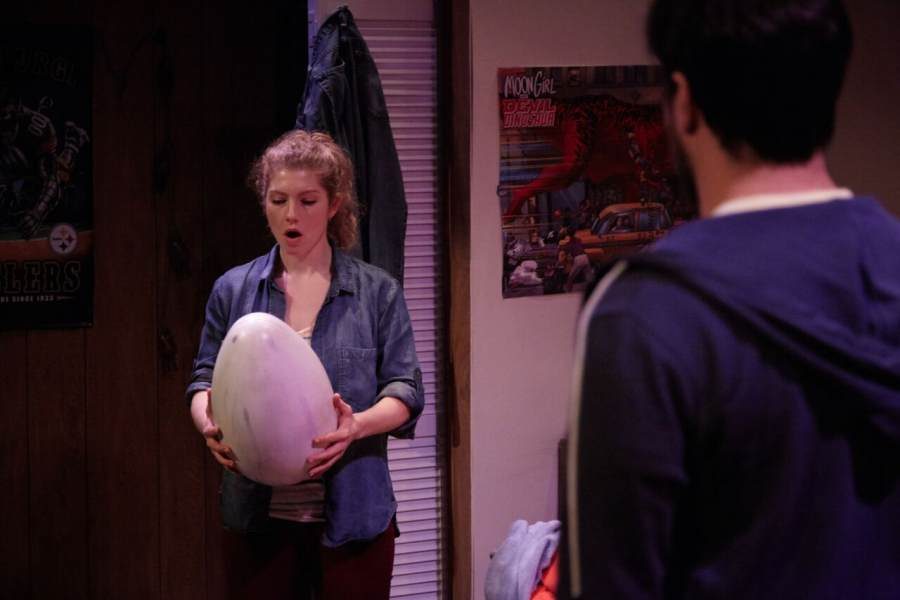

At a hasty first glance, Alexander V. Thompson’s Pete Rex—staged by The Dreamscape Theatre, in a New York premiere at 59E59 Theaters—may seem a piece of comic whimsy about a world in which dinosaurs once again roam the earth. Soon, though, the play emerges as an allegory about the barriers humans erect to protect our vulnerable hides, and how those barriers stand in the way of our potential for happiness and growth.
When we first see mid-thirties-ish Pete (Greg Carere), he is playing a decade-old X-Box football game with his bro, Bo (Simon Winheld), in a funky man cave in New Kensington, PA. Pete has tossed his empty Dr. Pepper cans on the floor beside his couch as if they were so many gnawed mastodon bones discarded by a Neanderthal slob. Anxious and edgy, Pete dreads the arrival of his girlfriend, Julie (Rosie Sowa), who is leaving town for NYC, and leaving him behind. Pete is also suspicious that something romantic may be going on between Julie and Bo.
When Julie arrives, she is in a panic. She claims to have just seen a dinosaur scoop up and carry off an elderly woman. TV reports confirm quickly confirm that thunder lizards are indeed running rampant all over town.
Soon we learn that Pete had stuffed a football-sized object that may have been a dinosaur egg under his couch. Now, it seems, his couch-potato presence has, in effect, hatched it. And it’s here that the play’s symbolism becomes so obvious that anyone who’s skimmed a Wikipedia article on Sigmund Freud might feel qualified to diagnose Pete’s ills.
Pete has always been a “dinosaur guy.” As a child, he stood a toy tyrannosaurus beside his bed to ward off monsters. In the schoolyard he stomped about like a T-Rex himself, as a way to rail against classmates who wouldn’t invite him into their games. Now, as an adult with a stunted education, few opportunities for economic advancement, and the woman who cares for him about to split, he is depressed, defeated, and bitter. It’s understandable that he feels like he’s being stalked and preyed upon, about to be devoured by life.
The allegorical components of the play prove to be moderately interesting. What is most wonderful about Pete Rex is Thompson’s creation of the nasty creature that breaks out of its shell in Act 2. “Nero Rex” (Winheld), the human-sized dino hatchling, is polite, urbanely thuggish, and very British. He’s like a menacing character out of the darkest of Harold Pinter plays, only with scales and tiny arms with claws. Winheld—like Carere and Sowa—gives a respectable performance playing human. But he truly comes alive when he goes reptilian. He’s first-rate, in fact. His fetching costume, by Caitlin Cisek and Melody Brocious, is part Blade Runner and part Jurassic Park. (Cisek also designed the show’s set.)
Throughout the show Thompson’s story frequently evokes Eugène Ionesco’s Rhinoceros, especially in scenes in which the marauding adult monsters launch an attack on Pete’s abode. Megan Culley’s impressive music/sound design helps make the barely glimpsed beasts seem real, as do the shadowy forms created via Remy M. Leelike’s lighting design. Director Brad Raimondo brings the right energy to these scary-comic action scenes.
Pete Rex may be a slight play, but it’s well constructed, thoughtful, and amusing. It’s Thompson’s first full-length play to be produced in New York, and it’s a solid debut.